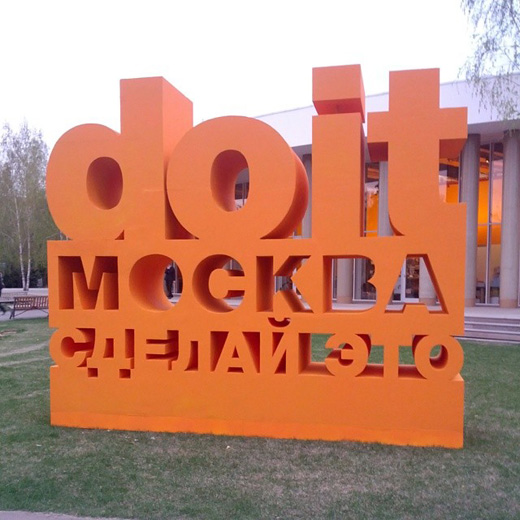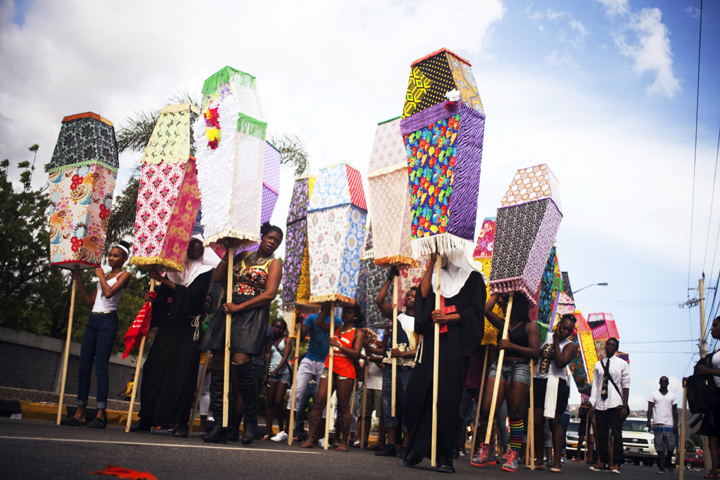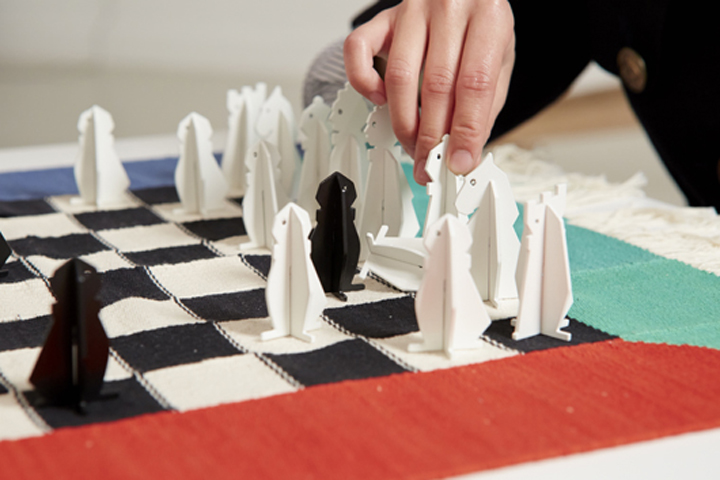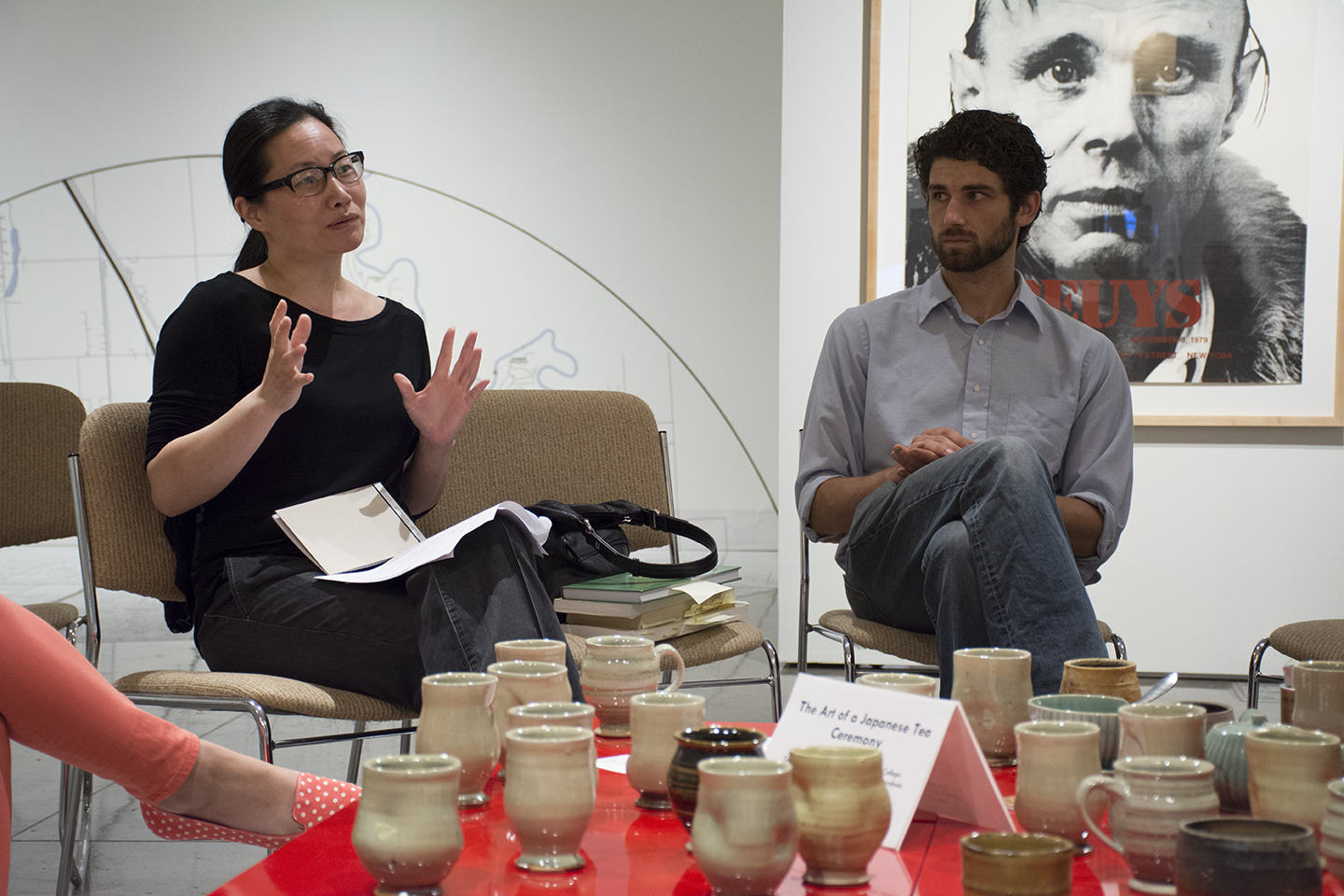Posted on August 12, 2014

By Anna Vestergaard Jørgensen
Since the early 1970s, Brooklyn based artist Martha Wilson has been experimenting with both male and female identities. In her work A Portfolio of Models (1974) Wilson takes on different female identities like “the professional” and “the goddess,” and she has been performing as political personalities such as Tipper Gore and Barbara Bush throughout her career. In 1978 Wilson founded the musical group DISBAND together with other women artists who could not play any instruments. Only two years earlier, Wilson had opened the alternative art space Franklin Furnace where I met her for a talk about identities, feminisms, collaborations – and aging.
AVJ: In the Martha Wilson exhibition there is not only the collaboration between you and the curator(s) but also a sort of collaboration – or “meeting” – between your own works that you selected for the exhibition and the local institution’s archive, collection, or community. Why is the inclusion of the local important in an exhibition about Martha Wilson?
MW: That was Kate Fowle’s idea, and it is a really good idea (1). She wanted the program of the entire organization to – not be sending out a box, having people unpack the box and not having the opportunity to respond and think about the contents of the box – but to be about engagement. So I believe ICI has done a fine, fine job of changing the curatorial field in general with this concept that “we’re in this together.” At Utah [Utah Museum of Fine Arts] for example they asked me to curate a show out of their permanent collection that would complement the show downstairs, that had come out of the box. So we did a Garry Winogrand/Helen Levitt photography exhibition that is about the gaze. It is about the female gaze and if there is such thing as a female gaze, which reaches back to the questions that are raised by the material in the show. So the answer to the question is, it is indeed a meeting of my work with local resources and we have Kate Fowle to thank.
AVJ: In the Martha Wilson Sourcebook, you reflect on the one hand on the role of the artist as a person that “can, do, and should change public discourse with their ideas,” and on the other hand you write: “Is art a form of therapy. I think so.” How do these two positions towards art – the socially engaged and the more inward turned – come together in your practice?
MW: I don’t know whether these are mutually exclusive ideas. I am the curator also of the performance artist festival at BAM [Brooklyn Academy of Music] in October, and the three artists I selected and the BAM staff met last night, and we had a discussion about audience. One of the artists, without any prompting from me, cited Erving Goffman – who is in the Martha Wilson Sourcebook; a sociologist who was writing in the middle of the 20th century – about how performance is what we do as we are alive and functioning in the world. You are performing as a student who is growing up to be a curator. I am performing as an old lady who runs an organization plus is an artist. Plus we are performing for history. We are thinking about ourselves in relation to all time. But I think what came out of our discussion was that the primary audience is the audience of one, the self, and then the relationship of that audience of one, the self, to the various onion-audiences that surround us is what we are doing. That is what performance art really is. Theater has an audience that expects to be lulled into a state of willing suspension of disbelief where you believe you are in the 18th century or you are on the barricades in France. But we generally, not always, but generally put our audiences into “smack” this moment where it is Wednesday afternoon at 2pm, it is not raining, you know this is really happening now. So the two poles of performance and the two poles of audience as well – I do not see a contradiction. What I see is a continuum between one’s internal sense of audience and then one’s appeal to a wider audience.
We [Franklin Furnace] just went through our peer review panel: five artists sitting around a table and then Martha is not allowed to vote but she is allowed to yell. So we’re talking about who we are giving the money to, and the artists around the table are – for a lack of a more refined term – they are trying to change the world in some small way. And these artists that we selected are trying to change the world in some small way as well. For example there was the artist we gave money to two years ago. First he collected 30,000 aluminum cans, numbered them and signed them all, put them in a globe, then suspended the globe in front of the Unisphere which is a big sculpture of the world in Flushing Meadows-Corona Park in Queens, and then he had people helping him to pull the draw string and drop the 30,000 aluminum cans on his head to protest our culture of waste (2). So he is very directly wanting to send a message to both the art world people who were there and also the regular people who were taking their kids to the park to play soccer. I thought it was very successful. He is Taiwanese, and he speaks English but it is not so easy to figure out what he says all the time, so he speaks to us with his actions.
AVJ: So you could say that art can be therapy both for you and for society?
MW: That’s a good way to look at it. Actually I had not thought of it, I think that is very good, thank you. I mean, I was thinking about myself, and if we were not artists we would all be psycho-killers, but luckily we have art. But then there is the audience, the therapy for the audience – that is a very good point. Now mind you, the term that was used – it was a pejorative thing to be said about your work back in the 70s – was that art was “self-indulgent.” That it is not pure concept, that it has something to do with therapy or getting feelings out of your system. And I think that the feminist movement can be credited with reclaiming the value of art practice as a “so what if it is therapy, so what if it helps the artist to get through stuff.” It is a way to externalize ideas for yourself and also for other people.
Martha Wilson, Working Girl and Goddess, from A Portfolio of Models, 1974.
AVJ: In the early 1970s you began experimenting with female identities, and you have for example “invaded” personalities such as Tipper Gore and Barbara Bush by performing as them. Have your identity experiments changed throughout the years and are there new (female) identities to be explored and experimented with today?
MW: Well I started with male identities. In the course of DISBAND – the all-girl band of women artists who cannot play any instruments – I was Alexander M. Plague, Jr. pretending to be Alexander Haig who was our Attorney General. So when Reagan got shot he said, “I’m in charge!” – but he was not, that was not correct at all. But he was the kind of guy who wanted to be in control of everything. He was very short, you know, and he was very embarrassed about being too short, so he had a box he would stand on behind the podium, really. And his son became a hairdresser, which was like “so embarrassing.” So I was Alexander Plague and then I had the opportunity to do something for SoHo TV, so I tried doing Ronald Reagan and I thought that was really unsuccessful. Then I got invited to be in the Artists’ Call Against U.S. Intervention in Central and South America and found Nancy. Nancy Reagan. So I started with Nancy Reagan and then became Barbara Bush quite reluctantly during the first Bush years. Then during the Clinton years, Bill Clinton was present for the MTV inaugural ball, which was televised. I was watching TV, and Clinton comes out with this sea of youth – American youth – all around him. “Our president is playing the saxophone!” – everybody was so happy – “Oh my God, he is playing the saxophone!” So Bill Clinton comes out, playing the saxophone, and then Hillary comes out after him, and then Al Gore who looks like Frankenstein comes out, and then Tipper comes out. Everybody is cheering, everybody is happy, and the mood of the room completely changes. It goes kind all silent when Tipper comes out, and then they booed her off the stage.
AVJ: Why?
MW: Tipper Gore had successfully won a lawsuit and gotten legislation putting parental advising labels on records and CDs. That was Tipper’s cause, and the youth of America had not forgotten her and not forgiven her for doing that. Plus Frank Zappa had died. There had been a lawsuit and then Frank Zappa had died – I mean she was not a cause of that but people were unhappy about that. So I thought I had to do Tipper, and I did Tipper during the Clinton years. Then George W. was elected, so I decided to be the mother of the president. And I have been the mother of the president – now ex-president – since then. Now Barbara did a performance just last fall where she takes off her clothes and just stands in underwear. I have never done this before. Barbara is a very straight-laced personality but for this performance I decided to take her clothes off.
So in answer to your question, I am not looking at either new male or new female identities because I have this wonderful suit. Actually I have two suits for Barbara – one for summer and one for winter. She was just on the morning news today; I saw Barbara Bush’s face on the morning news. So I am kind of interested in the role that she is playing as an American elder – you know a person we turn to for advice – and she was saying that she did not think that we should keep going for the Bush dynasty or the Clinton dynasty, we should try to widen our political net to include people who have not sought high office before. I don’t know. I sometimes quote her; I sometimes quote what she actually said, but then I wipe out parts of what she really said and take her to journeys where she would never go.
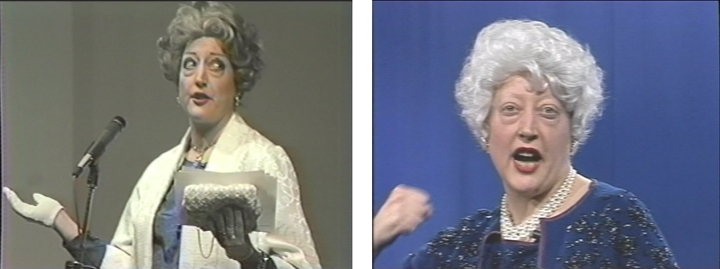
Martha Wilson as Nancy Reagan (1985) and Barbara Bush (1991).
AVJ: So you still have enough material in these persons to continue working with them?
Barbara is very rich. She is, well, fat with potential subjects. In one of the performances I admit that George W. and Saddam Hussein were fraternal twins. That she kept the kid who looked like her husband and sent the other one to an orphanage in Baghdad. And actually Saddam Hussein was raised at an orphanage in Baghdad, so I mean… I am totally making up the fraternal twinness, but I thought that was a nice connection to the real world. I don’t know, I am getting older and fatter so I cannot be Michelle [Obama], because she is too hot. I don’t know where I am going with my career as an aging performance artist. I am not quite sure about that.
AVJ: In the Martha Wilson Sourcebook you write about DISBAND that “We saw only a black future, and thought the world was going to end soon.” What do you see today?
MW: What I want to say about DISBAND is that the songs that we were writing in the 70s seem to be still relevant, and that is a very upsetting thing. The climate change is still an issue, Iraq and Iran is still an issue, violence against women is still an issue. All the same things that we talked about are right here and not moving, although I think our attitude has indeed changed. I mean nobody could imagine a bright future in the 70s. It was very dark. The feminist strategies had not worked; race-relations were not in great shape; and climate changes – we were joking that Ohio would be oceanfront property! So I think that the mood has changed in that we now think that technology will save us all. But if you talk to the climate people then you get depressed all over again. Honestly, I am relying on my son who is working for a green cooperation. I am relying on your generation to save us. Change the world and save the planet!
AVJ: But in general you are more positive now than you were in the 70s?
MW: I feel better. I don’t know if that is rational, but I do feel better. Of course, if you look at the Middle East – that is the biggest mess since… Even in the Cold War we were not shooting at each other, we were just threatening to shoot. I don’t know, I go back and forth, not knowing how to feel.

DISBAND, performance at MoMA PS1, 1979.
AVJ: Collaborations with other artists seem to have been a crucial part of your artistic practice, and the current Martha Wilson exhibition is made in collaborations with the curator(s) at the local institutions. Can you elaborate on what collaboration means to you and if you see it as a particularly feminist practice?
MW: So I wanted to save the best for last and tell you the story that Connie Butler did a show – she was a curator at the Museum of Contemporary Art in Los Angeles, then she got hired by Museum of Modern Art [MoMA] – and the big show that she put together was called WACK! (3). I managed to go to every single venue where the show was to see how it looked installed in each place it was. And what I liked so much about this show was that it revealed how this term that we use today – feminist – consisted of perhaps ten different camps of women with ten different thoughts about what the heck feminism was. For example, there was the Pattern and Decoration artists like Joyce Kozloff; then there was the Goddess artists like Mary Beth Edelson; and there were performance and video art as DISBAND, Y Pants, and other bands; and performance/photography people. There was no agreement as to what the heck feminism was, plus there was no agreement as to what the performance of feminism should be. Should we be wearing makeup? Should we be talking to men? Should we all be lesbians? What are we going to do about women who are doing imagery like Judith Bernstein was doing of giant screws – obviously phallic symbols? What are we going to do about Hannah Wilke who is a gorgeous creature? Is she allowed to be a feminist if she is a tabloid beautiful person? How does this function in relation to feminist discourse? So there was a lot of yelling. There was a lot of collaboration but there was also a lot of yelling, and Judy Chicago made me cry. I thought I would tell this story as the grand finale for this interview. So I was doing these photo-text works, it was 1972, my boyfriend was interviewing for a job at CalArts (4) and I showed the earliest stuff that I have done to a class Judy Chicago was teaching at CalArts. CalArts had given her class – the feminist art workshop – the gymnasium, because the kids were not athletes and they were not interested in playing basketball so they just gave it over to the feminists. So I showed my work and then Judy Chicago said “Well how do you like what you see around you?” And I looked at the walls of the gymnasium and they were painted with images of flowers and boobs. And I thought it was horrifying. I did not want to say it was horrifying, so I said, “Well it looks prescriptive to me,” and she said “DON’T YOU UNDERSTAND WHAT WE’RE TRYING TO DO HERE? WE’RE TRYING TO SUPPORT THESE YOUNG WOMEN!” She started yelling at the top of her voice and I am just a baby feminist – I did not know a feminist could do that! What she was saying was that what I was doing was not feminist. She was saying: “This is not feminist art.” So I just started to cry! You know, I just did not have enough emotional resources to draw upon. So I have never really forgiven Judy Chicago and the Central Core Imagery camp for trying to get feminism to look like only that.
I was going point something out. Half the time artists do not know what they are doing. They are doing the work but they are not quite sure of what the effect of the work is, and Michelle Meagher points something out in this wonderful article that compares moi with Cindy Sherman and also with Suzy Lake who is an American who lives in Canada: “But it is Wilson, by producing images that embody the passing of time, that gets at the experience of aging in ways not accomplished by Lake and Sherman. Wilson’s work makes me cringe, but not because I am faced with Sherman’s failed performances of socially delimited feminist aging or with the bodily excesses of Lake’s plot, but because she manages to express the personal and political stakes of contemporary – albeit longstanding – demands that women quietly move into invisibility” (5). I thought that was really good, and in another part she talks about the piece of mine, Name = Fate, which employs an image of US president Bill Clinton: “A gesture towards the ways in which aging is associated with masculinization for women also speaks to the ways that male aging is less abject, less shameful, than female aging.” Which I had not really thought about, but I think that is valid. She saw that.
AVJ: And is aging something you thought about when you did the Bill Clinton piece?
MW: No, I was thinking about how the title of the work is Name=Fate. Martha Wilson turned into a performance artist and William Jefferson Clinton turned into the president of the United States. I mean, what are you going to do with a name like William Jefferson Clinton? So I was not thinking about these issues of age, but like I said – it is a valid interpretation of that piece.

Martha Wilson, Breast Forms Permutated, 1972.
AVJ: Getting back to the question about collaborations, are you saying that feminism is more about disagreement than about collaboration?
MW: Collaboration is hard. In the early days of DISBAND I caught myself trying to hit one of the other members – Diane Torr – with a frying pan. Luckily, I did not hit her, but I was so angry about something. I no longer remember what I was so angry about either. And then DISBAND – not every single member of DISBAND, but three out of four members – went up to MacDowell Colony (6) in 2011 and we are still arguing with each other, because we are trying to change the world. We are trying to get to the audience and change their hearts and minds, and what is the stuff that will do that and how are we going to do that? We were going back to the federalist papers and looking at the founding documents of this great nation of ours and then impersonating George Washington, Thomas Jefferson, and Benjamin Franklin. Really it was about how the Tea Party has taken us away from founding principles. The founding fathers were all in favor of science, and the Tea Party is trying to say that we should all be Bible Belt Christians. So it is not life and death, and I did not try to hit Diane on this trip in 2011, but there is still a lot of bumping to get to the point where we agree enough to come up with a song, song lyrics, and a message.
AVJ: And how did you recover from your meeting with Judy Chicago?
MW: My boyfriend did not get the job at CalArts, so we went back to Halifax. I did not want to do Central Imagery, I did not have any other direction that I wanted to take, so I just kept doing what I was doing.
_____
Notes:
(1) Kate Fowle is Director-at-Large at Independent Curators International (ICI)
(2) Chin Chih Yang, Kill Me or Die, 2012.
(3) WACK! Art and the Feminist Revolution (2007) was the first comprehensive, historical exhibition to examine the international foundations and legacy of feminist art in the period 1965-80.
(4) California Institute of the Arts.
(5) Michelle Meagher: “Against the Invisibility of Old Age: Cindy Sherman, Suzy Lake, Martha Wilson,” in Feminist Studies 40.1, 2014.
(6) MacDowell Colony is an artists’ colony in Peterborough, New Hampshire, United States.
The exhibition Martha Wilson is touring until the end of 2015.
***Anna Vestergaard Jørgensen is currently an Exhibitions Intern at ICI. She is completing her Masters in Art History with Elective Studies in Curating and Cultural Heritage at University of Copenhagen.

